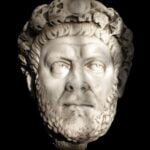Octavian Augustus after taking power introduced many propaganda solutions that were to tie the people to the new ruler. He adopted republican titles, erected many monuments showing the divine grace resting upon him, and built magnificent buildings in the “Eternal City”.
He also launched a new military unit – imaginiferi. Imaginiferi (from the words “imago” – image, and “fero” – to wear) were part of principales (non-commissioned officers), belonging to signiferi (bearing the signs). Their main task was to wear a depiction of the current ruler of the Roman Empire. The imago itself was most often three-dimensional and presented the ruler in the form of a bust. It ranged from 25 to 30 cm and was hung on a pole, showing the emperor usually in armour1. Imaginiferi brought to the battlefield the image of the one for whom the soldiers fight and die. Also during all military ceremonies, they carried the image of a ruler before whom military oaths were taken. Probably it was imaginiferi who also cared for the emperors’ representations by lubricating them (as Pliny informs us in HN. XIII 4) and decorating them for religious holidays. It seems that they also took part in the care of the camp temples (aedes), where apart from the images, military banners were placed.
The image of the emperor itself was treated with religious reverence, so we can read about using it many times. Suetonius (Suet. Cal. 14) and Cassius Dio (Cass. Dion. 59.27) told their readers about a Roman official who received obeisance on behalf of the Emperor from Parthian King Artabanos. The party husband did it not before the emperor himself, but just before his presentation, and the act itself sealed the peace between the powers. Similarly, in Tacitus’s opinion, peace was to be made with the King of Armenia, Tiridates, forcing him to remove the diadem in front of Nero’s painting (Tac. Ann. Xv 29.2-3). We can also read about the senator forcing the act of humbling the barbarian rulers in front of the image of the then emperors on one of the tombstone inscriptions, where the deceased Roman gladly informed about it (CIL XIV 3608).
The image of the emperor showed his majesty – and his majesty was equated with the Roman Empire. Thus, the offense in the vicinity of the image was prosecuted with all severity since the times of Tiberius (Suet. Tib. 58). Convicts who were guilty of entering the lupanara or the latrine could find out about it, carrying coins with the image of the emperor.
With the death of the pagan religion, many elements of the world then disappeared. Some of them adapted their overtones to the new order – this was the case with our imaginiferi. In the Christian world, depictions of emperors were treated as images of God’s anointed (Athan. Or. Adv. Arian III 5), and the authorities naturally expected them to be worshipped. Bishop Severian, who lived at the turn of the 4th and 5th centuries, wrote directly about the veneration of images by the people – what is more, it was supposed to be understandable and inevitable2. After all, the Emperor couldn’t be everywhere. Therefore, in 383, the emperors wrote an interesting law in the event of, for example, military victories. With the new law, they allowed their saints to enter the city of their faces in a solemn way to receive the devotion from the successful people (C. Th. VIII 11.).
Thus, the imaginiferi were more than just warring the image of the emperor: they were keepers of sacred objects, and recipients of loyalty and honor on behalf of the emperor. It was also them who brought the ruler’s images to the city, where they were hosted during military victories and ceremonies, as if the rulers themselves were present. Imaginifer, as a product of Octavian Augustus to legitimize the new power in the army, did not disappear in Christian times. He remained in the fourth and fifth centuries the one who, while wielding imagines,, received loyalty from soldiers, often reflecting also the religious reverence for the imperial authority.







